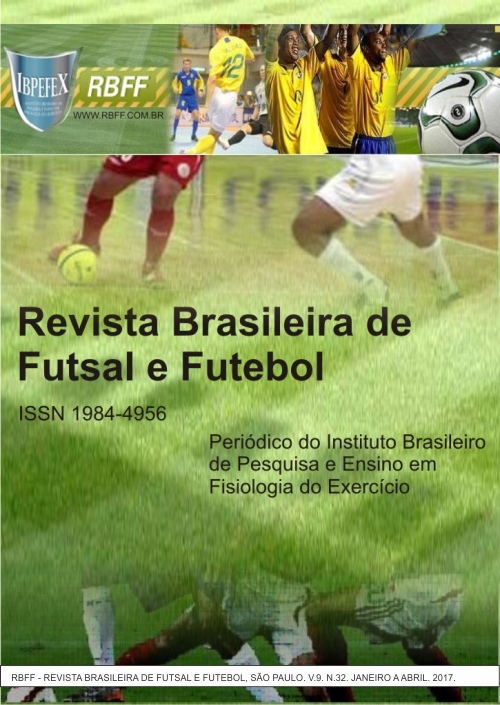Maximum oxygen consumption (VO2) in professional football athletes of different game positions
Abstract
The maximum consumption of oxygen (VO2 max) is defined by the maximum pulmonary oxygen capture and by the result of its transport and use during physical exercise. In order to measure it, ergospirometry is the recomended test, due to its capacity to identify the anaerobic limit, as well as allowing higher levels of maximum VO2. This study aimed to compare the maximum consumption of oxygen amongst professional football players in different positions by means of ergospirometry. A group of nine professional football players from the club Tuna Luso Brasileira, Belém, PA, being one goalkeeper, two defenders, two wings, two midfielders and two forwards, all in ages ranging from 19 to 31 years(±23,8), mean height of 179,6 cm (±7,5) and mean weight of 73,1 kg (±6,2). The collected data shows a significance for the position played with the results for VO2max. The results show that midfielders and wings achieved a higher consumption amongst the analysed positions. Goalkeepers, defenders and forwards showed no significant differences in result. Therefore, we can affirm that midfielders and wings, due to higher mobility during a match, obtained higher values during the tests, if compered with the remaining positions studied.
References
-Al-Hazza, H.; Al-Muzaini, K.; Al-Refaee, S.; Sulaiman, M.; Dafterdar, M.; Al-Ghamedi, A. Aerobic and anaerobic power chracteristics of Saudi elite soccer players.J Sports Med Phys Fitness. Vol. 41. p. 54-61. 2001.
-Arnason, A.; Sigurdsson, A.; Gudmundsson, I.; Holme, L.; Engedrebsen, B.; Bahr, R. Physicial Fitness, and Team Performance in Soccer. Med Sci Sport Exerc. Vol. 36. p. 278-289. 2004.
-Barros, T.; Guerra, I.(orgs.). Ciência do futebol. Baruerí. Manole. 2004.
-Balady, G. J.; Arena, C. R.; Sictesema, K. Clinician`s Guide to Cardiopulmonary Exercise Testing in Adults. Circulation. Vol. 122. p. 191-225. 2010.
-Balikian, P.; e colaboradores. Consumo máximo de oxigênio e limiar anaeróbio de jogadores de futebol: comparação entre as diferentes posições. Rev Bras Med Esp. Vol. 8. Núm. 2. 2002.
-Bangsbo, J. The physiology of soccer-with special reference to intense intermitente exercise. Acta Physiol Scand. Vol. 15. Supply. 619. p. 1-156. 1994.
-Bell, W.; Rodes, G. The morphological characteristics of the association football players. J Sports Med Physbooks; 1998.
-Cohen, M., Abdalla, R.; Ejnisman, B.; Amaro, J. T. Lesões ortopédicas no futebol. Rev Bras Ortop. Vol. 32. Núm. 12. p. 940-944. 1997.
-Costa, E.C.; Guerra, F. E.F.; Knackfuss, M. I.; Nunes, N. Consumo máximo de oxigênio de jogadores de futebol profissional de uma equipe Potiguar: comparação entre diferentes posições. Revista Brasileira de Prescrição e Fisiologia do Exercício. Vol. 1. Núm. 5. p. 11-17. 2007. Disponível em: <http://www.rbpfex.com.br/index.php/rbpfex/article/view/43/42>
-Cochrabe, B.; Pike, F. Physiological assessment of the Australian soccer squad. Ther Australian Journal Health. Physicaleducation and recreation. Vol. 4. p. 21-25. 1976.
-Cunha, R. M. Ergoespirometria: Padrão ouro na prescrição de exercícios na reabilitação e condicionamento cardiopulmonar. Revista Movimenta. Vol. 6. Núm. 2. 2013.
-Davis, J. A. Pre-season physiological chracteristics of English first and second division soccer players. Journal of Sports Sciences. Vol. 10. Num. 6. p. 541-547. 1992.
-Dos Santos, R. C.; Mardock, C. B. J.; Andreade, E. C.; Junior, S. B.;Matos, W. M. T. Analise Ergoespirometrica em jogadores de futebol profissional no Paysandu Sport Club. Nova Fisio, Revista Digital. Ano 15. Núm. 86. 2012
-Njafi; A.; Shakerian, S.; Habibi, A.; Shabani, M.; Fatemi, R. The comparison of some anthropometric, body composition indexes and VO2max of Ahwaz elite soccer players of diferrent playing positions. Pedagogics, phychology, medical-biological problems of physical training and sports. Vol. 9. p. 64-68. 2015.
-Texeira, B.; Cassales, M.; Ribeiro, J. Comparação de consumo máximo de oxigênio e limiar anaeróbio de jogadores de futebol que atuam em diferentes posições. Efdeportes. Rev Dig. Vol. 14. Núm. 114. 2010.
-Timpka, T.; Risto, O.; Bjormsjo, M. Boys soccer league injuries: a community-based study of time-loss from sports participation and long-term sequelae. European Journal of Public Health. Vol. 18. Núm. 1. p. 19-24. 2008.
-Silva, G. E.; Vivia, R. C.; Pergher, R. L.; Porto, F.;Gurgel, J. L. Capacidade cardiorrespiratória entre meio-campo e atacantes da equipe universitária da PUC-RS. Disponível em http:/www.pucrs.br/feng/microg/labs/numa/produção/2007/sic/49682_gabriel_espinosa_da_silva.pdf; acesso em 20/10/2015.
-Souza, J.; Zucas, S.M. Alterações da resistência aeróbia em jovens futebolistas em um período de 15 semanas de treinamento. Revista da Educação Física / UEM. Vol. 14. p. 31-36. 2003.
-Vasques, F.S.; Machado, R. R. M.; Navarro, F.; Navarro, A. C. Consumo máximo de oxigênio (VO2max) em atletas amadores de futebol durante o período de competição. Revista Brasileira de Futsal e Futebol. Vol. 1. Núm. 1. p. 53-63. 2009.
-Wilsoff, H. U.; Hoff, J. Strenght and endurance of elite soccer players. Br. J. Sports Med. Vol. 38. Núm. 3. p. 285-288. 1998.
Authors who publish in this journal agree to the following terms:
- Authors retain the copyright and grant the journal the right of first publication, with work simultaneously licensed under the Creative Commons Attribution License BY-NC which allows the sharing of the work with acknowledgment of the authorship of the work and initial publication in this journal.
- Authors are authorized to enter into additional contracts separately for non-exclusive distribution of the version of the work published in this journal (eg, publishing in institutional repository or book chapter), with acknowledgment of authorship and initial publication in this journal.
- Authors are allowed and encouraged to post and distribute their work online (eg, in institutional repositories or on their personal page) at any point before or during the editorial process, as this can bring about productive change as well as increase impact and impact. citation of published work (See The Effect of Free Access).





